_The word “forgotten” is often used in relation to female designers and artists, implying that it is an unconscious, uncontrollable, and unintended process. However, people are not forgotten by chance; they are written out of history. Writing history always involves actively selecting from the diversity of events, people, and works. This selection reveals whose work we consider important. _(Beyerle/Meer 2024: 61)
The Klingspor Museum in Offenbach collects modern and contemporary book and type art. It is also home to a large estate from the former type foundry Gebr. Klingspor in Offenbach. In July 2024, the exhibition Same Bold Stories: Type Design by Women and Queers in the 20th and 21st Centuries opened at the Klingspor Museum. The group show was developed through a collaboration between Klingspor Museum, the design studio turbo type and the feminist collective +FEM, bridging historical and contemporary positions in type design. Same Bold Stories offers an opportunity to reflect the contributions of FLINTA* (Female, Lesbian, Inter*, Non-binary, Trans* and Agender) designers to history and practice, as well as institutional processes of collecting. While preparing the exhibition, the curatorial team encountered more questions than they were able to answer, prompting a prolonged and necessary confrontation with established narratives in design research and with the limitations of museal institutions. Written from the perspectives of two of the exhibition’s curators, this essay aims to present and reflect on central motifs and problems of Same Bold Stories, especially with regard to practices of collecting and history writing, and to provide an outlook on possible future approaches to collecting and curating design.
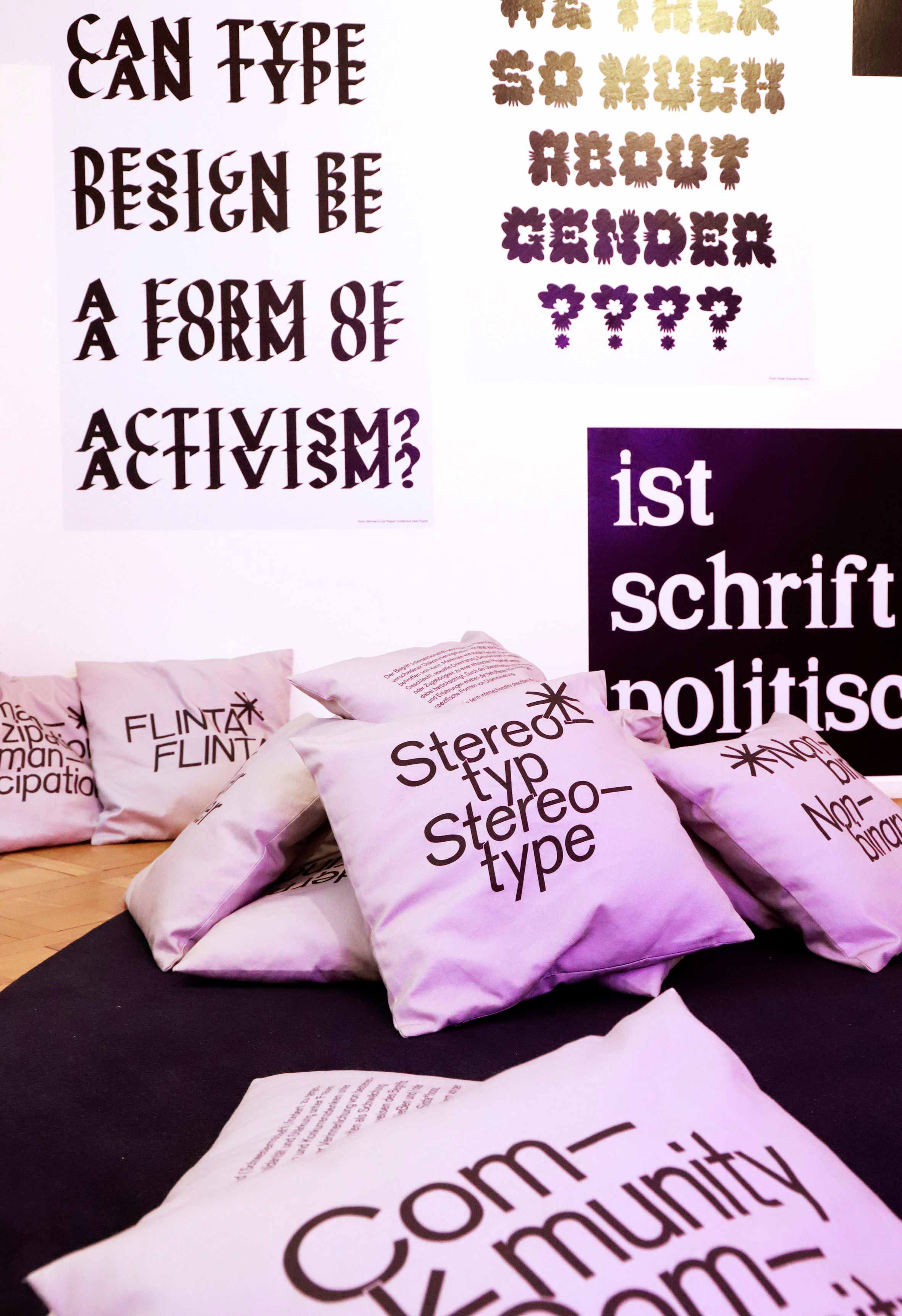 Exhibition view 2, Same Bold Stories, Foto: _turbo type
Exhibition view 2, Same Bold Stories, Foto: _turbo type
Canons, Collections, and Critique: Re-evaluating Type Historiography
Type design can be approached from various perspectives: its formal language and expressions convey time-specific fashions, evoking various associations and connotations. Type design can be activist, and play with or completely subvert conventions in a provocative manner. Consequently, type design is inherently political. The history of type design reflects social contexts and values, revealing the stories of the people who created and marketed it. History, on the other hand, is fundamentally shaped within itself by what is preserved, researched, and put on display. To place critique at the centre of design discourses that focus on marginalisation it is crucial to reflect on the structures of preservation. Academic disciplines and their established canons are informed by normative standards that determine what is considered valuable and worthy of preservation. Thus archives and collections are rarely neutral; they reflect deliberate choices, and reveal just one (his)story of many possible narratives – yet often masquerade as a representative whole. When considering what has been inscribed into the canon of design historiography, it is also important to acknowledge the blind spots and gaps that remain while individual oeuvres are highlighted. What and who was excluded from being researched in the first place and to what extent does this reflect the way museums collect and display artefacts? Are their archives equitable, authentic reflections of reality or are they shaped by historical biases that reproduce in present-day curatorial practices?
Women and queer identities, in particular, remain underrepresented in most major exhibitions and also in design historiography (cf. Eisele/Naegele 2024). When looking at this issue through the lens of intersectionality, one will further notice a correlation between the decrease in privileges and the increase of barriers in context of the representation of BIPoC individuals especially within the field of type (cf. Duke 2021). Nevertheless this is not solely the result of museum neglect but of profound societal forces preventing access: women for a long time were denied social participation, and consequently, equity. At the same time, queerness was (and often still is) viewed as deviant – an identity discriminated against, stigmatised, and forced ‘into the closet’ by social prejudice. This also interconnects and partly applies to different forms of ethnic and racial discrimination, even if those are not the main focus of this text. A more equitable approach to collection and exhibition development for all (regardless of class, gender, cultural or religious background) would not only grant equal opportunity to those positions who were historically othered.* It would instead actively address the systemic disadvantages that certain groups still face, and provide them with the support they need to thrive. Based on this, if the ideal of ‘equity’ is taken seriously, it requires more than just a call for parity: such demands need to be grounded in the fundamental principle that labour as well as resources are distributed to each individual according to their abilities, and according to their needs.**
Absent, Erased, Unmentioned?: Women’s Invisibility
While many historical accounts quickly assert that there almost were no female type designers in the first half of the 20th century, a closer examination suggests that women participated in many areas of type production. Their contributions are largely invisible today due to a lack of acknowledgement and documentation during their lifetimes. This situation underscores the selective nature of historiography: while some narratives are highlighted others are marginalised or fully erased. It remains a significant challenge to reconstruct the lives of those whose achievements were not documented.
In 1971, art historian Linda Nochlin posed the question “Why Have There Been No Great Women Artists?” In her essay, she analyses mechanisms of gender discrimination and the limited access to educational and professional opportunities to counter the misconception that women lack talent or ability. According to Nochlin, it is the systemic and institutional barriers that have historically excluded women from achieving success and recognition, thereby contributing to their invisibility in the arts. More than 50 years later, her question is just as relevant. Because one might be tempted to believe that there simply haven’t been enough talented women artists or that they weren’t as ‘great’ as their male counterparts – an obviously false conclusion. It is crucial to explain why women were not acknowledged 1) to demonstrate that visibility does not necessarily reflect the quality of a work of art or design, but rather indicates gatekeeping, and 2) to understand the complex processes involved in the formation and establishment of canons. Gatekeeping, a practice that excludes certain individuals from institutions, also has a significant economic component (cf. Del Prete/Rado/Sanoh 2020), while canons enhance and consolidate symbolic value. Structurally these notions – in an almost reversed-intersectional manner – accumulate privilege.
Another feminist approach focused on design and its historiography is Martha Scotford’s concept of a Messy History. It aims to challenge the traditional, often male-centred narratives by embracing the complexity and multiplicity of historical contributions. Rather than presenting a singular narrative, Scotford advocates for acknowledging diverse and marginalised voices which have received little attention historically (cf. Scotford 1994). Messy History is essential not only for re-evaluating the role of women in type design but also for engaging with postcolonial approaches to historiography. By applying a Messy History approach, the multi-layered nature of history is revealed – which is never defined by a single, objective truth. The notion of Messy History helps dismantle hegemonic narratives and supports a more inclusive and non-linear understanding of (design) history.
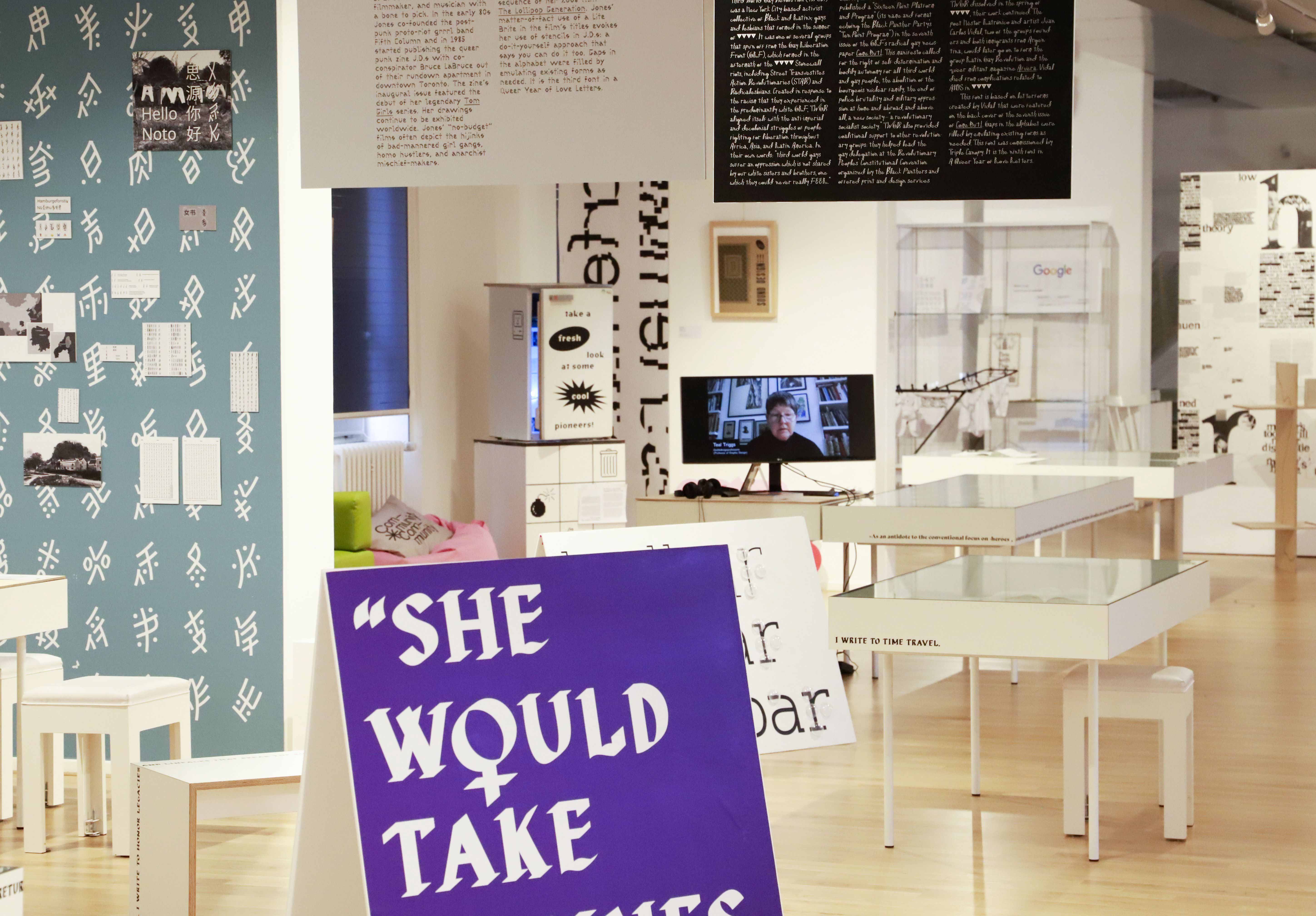 Exhibition view 1, Same Bold Stories, Foto: _turbo type
Exhibition view 1, Same Bold Stories, Foto: _turbo type
Type design is certainly one of the least permeable design sectors in the 20th century and to this day. Training locations and technical conditions favour the Latin writing system, thus European and North American type designers get more attention on a quantitative level (cf. Ben Ayed 2023; cf. Chahine/Meseguer/Rado 2024: 194–195, 200). In the 20th century, male dominance in this field obviously coincided with opportunities for education and work. But there are more complex reasons worth taking a closer look at: in fact, the research into typefaces designed by women and queers in the 20th and 21st centuries in the Klingspor Museum’s collection has shown that there were indeed several notable positions such as Editha (Dita) Moser, Erika Giovanna Klien, Anna Simons, Hertha Larisch-Ramsauer or Elisabeth Friedländer present already in the first half of the 20th century (cf. Ader/Ledenev/Prenzel 2024: 114-151). Although they weren’t included in historical records these female designers are probably just the tip of an iceberg yet to be explored. Similarities can also be observed with regard to other countries: Alice Savoie’s research on the women behind Times New Roman exemplifies how female employees, who meticulously documented their work on specific typefaces, played a significant role in the design processes of the British Drawing Offices (Savoie 2020). Despite their important contributions, the involvement of women has been overlooked or ignored in favour of linear historical narratives. By examining their roles, academic research can provide a more nuanced and accurate account of history, challenging the dominant narratives that emphasise individual genius. In context of Times New Roman, this means acknowledging that typeface production was a collaborative effort rather than an individual achievement.
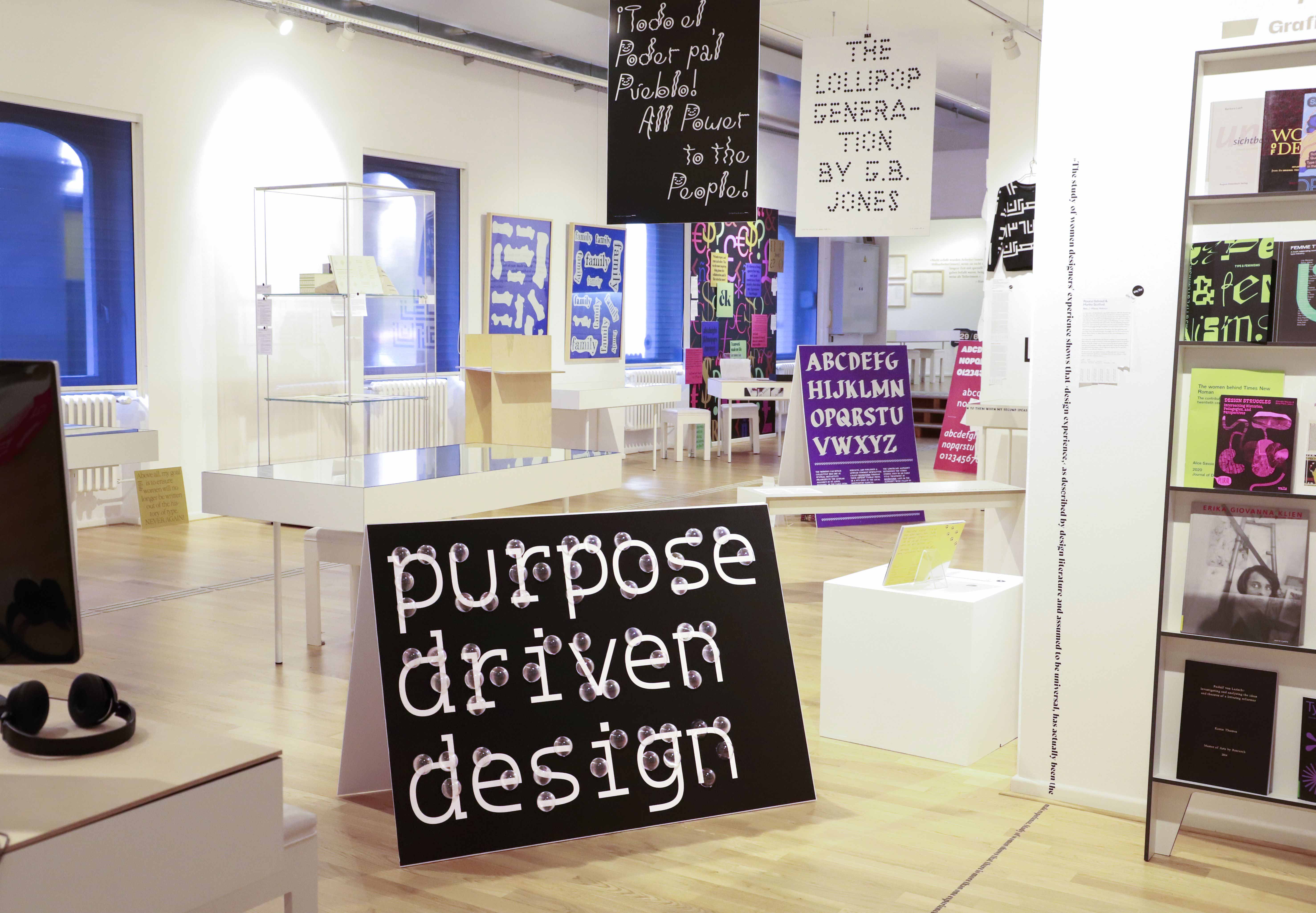 Exhibition view 3, Same Bold Stories, Foto: _turbo type
Exhibition view 3, Same Bold Stories, Foto: _turbo type
The Klingspor Museum’s collection offers valuable insight into the working processes of the Gebr. Klingspor type foundry in the early 20th century. While the type designers were indeed all male, the production process still relied on the contributions of many female workers. The museum’s collection features a typescript by Hans Halbey summarising the type foundry’s employee index from 1894 to 1956. In the introduction, the author notes that he documented only employees who had worked at the foundry for over five years and that individuals “were not included if they were not involved in special tasks over a longer period of time, for example as type sorters.” (Halbey cited in Ader/Ledenev/Prenzel 2024: 105) Of 493 names recorded, only 64 are female, indicating that the typescript is particularly incomplete concerning female employees at Klingspor: women’s careers often ended due to marriage, pregnancy, and similar factors, leading to shorter work periods (cf. Ader/Ledenev/Prenzel 2024: 105).
Photographs from the Klingspor foundry show female employees in many different places, and the job of type sorter seems to have been a purely female occupation: the finished typefaces were checked by the type sorter using the casting slip and arranged alphabetically in fixed units (cf. Ader/Ledenev/Prenzel 2024: 106–107). In the publication Schriftgießerei im Schattenbild (Type foundry in Paper Cut), Rudolf Koch describes the finished packaged unit of the type sorter with the remarkable words “underneath, full of verve, she boldly places her own name, like the artist does.” (Koch cited in Ader/Ledenev/Prenzel 2024: 107) The recognition of the type sorter in Koch’s text is a rare example of acknowledging women’s contributions to type production in the early 20th century. According to Cheryl Buckley, the silence about women’s work is a “direct consequence of specific historiographic methods. These methods, which involve the selection, classification, and prioritization of types of design […] are inherently biased against women and, in effect, serve to exclude them from history.” (Buckley 1986: 3) As a result, much of women’s involvement remains undocumented, often leaving only names, if anything, and making reconstruction nearly impossible.
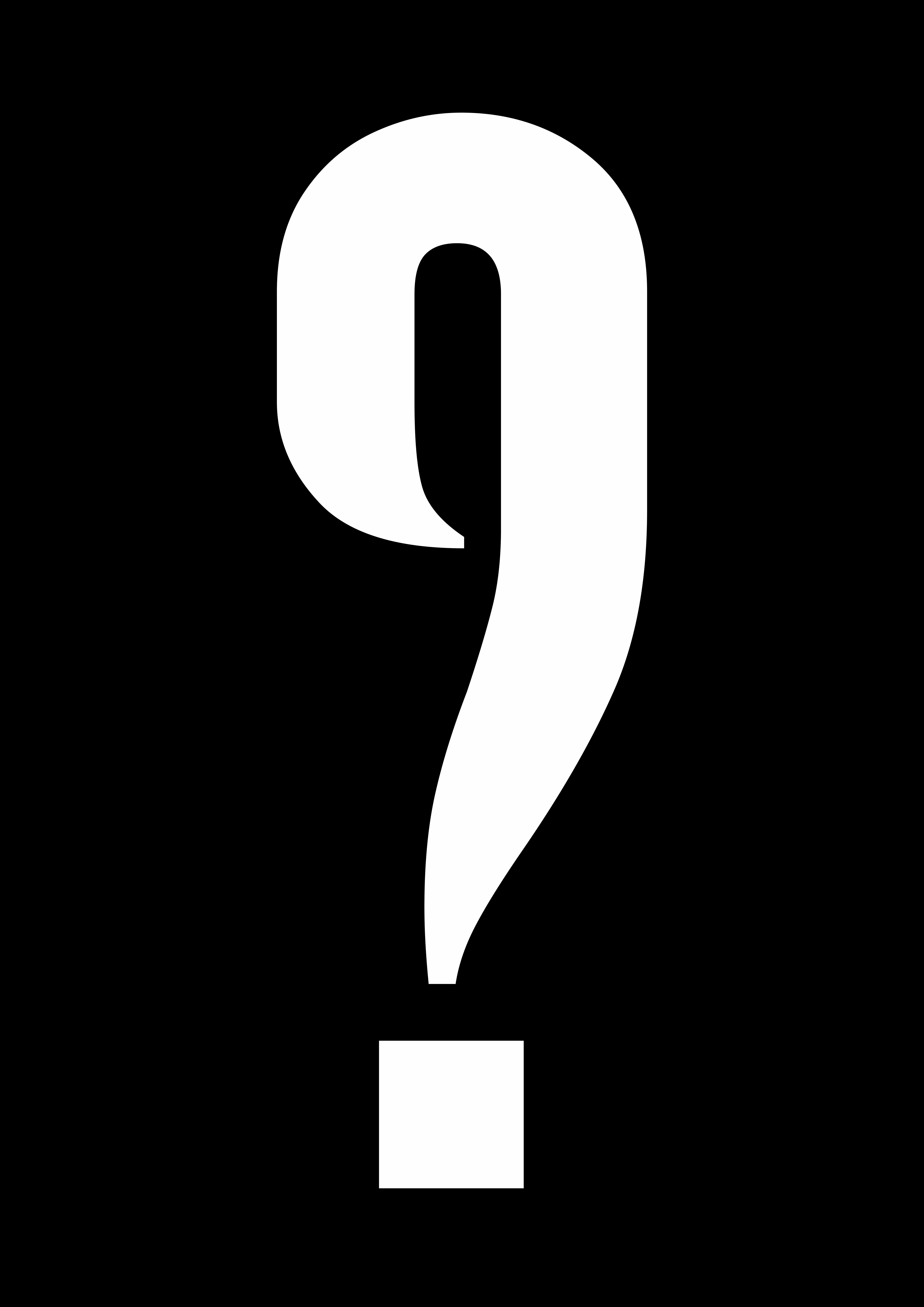 Font Gupper by Giulia Boggio
Font Gupper by Giulia Boggio
 Font Violet by Carmen Nacher
Font Violet by Carmen Nacher
The Politics of Preservation: Power Relations in Archive and Collection Development
Archives require significant maintenance and care, as their preservation demands continuous attention and safeguarding. In this way, the role of the archivist parallels a particular interpretation of curatorial work: the verb to curate comes from the Latin curare, en. to care for (cf. Buurman 2021: 21; for further reading on the notion of ‘curating as care work’ see: Krasny/Perry 2023). Both the curator and the archivist in this sense perform care work, ensuring that objects of cultural or historical significance are protected. However, the roles of archivists, curators and custodians have historically been male-dominated, despite the fact that the notion of care work is traditionally feminised. This reveals an inherent ambiguity and problem: while care work for children or the elderly is still a female (unpaid) domain, the professional care of high art has largely been entrusted to men, and therefore reproduces patriarchal structures. Even though more FLINTA* individuals now occupy archival and curatorial positions, the artefacts considered worthy of preservation are still predominantly those attributed to men’s legacies and genius, reinforcing a gendered hierarchy. This divide exemplifies how gendered divisions of labour and recognition continue to influence both, archival and curatorial, practices.
The Klingspor archive holds an extensive type-related collection that also includes type samples and documents from numerous other type foundries. Names of well-known, and exclusively male idols dominate this collection together with the narrative of heroes and exceptional talents who wrote type history in the 20th century. A fundamental aspect of a museum’s responsibilities lies in its ‘collection concepts,’ which define how a collection is structured and expanded. This process involves countless decisions, determining which contexts are significant and how these are reflected in a collection. Unfortunately, within an institution, particularly one with a long tradition of collecting, decision-makers are never entirely independent; structures and thought patterns change slowly. In recent years, museums increasingly re-examine their collections considering these deficiencies in the representation of women and other marginalised positions.
This one-sided approach to collecting has multiple underlying reasons, but one in particular places female contributions at a significant disadvantage. Many collection concepts continue to adhere to a narrow definition of what constitutes valuable works, primarily focusing on individuals whose lifetime achievements are characterised as ‘oeuvres.’ Especially when examining earlier periods, fewer bodies of work by women are found to align with this criterion. The Klingspor Museum’s cataloguing of female type designers has revealed numerous working biographies from the early 20th century, often marked by brief, intense creative periods that were abruptly ended due to marriage, motherhood, displacement, or economic challenges. The inclusion of these positions in the collection is often coincidental. As a result, the collection largely reproduces a one-sided, linear narrative, reflecting the concept described by Scotford as a Neat History (in contrast to a Messy History).
In type design, a fundamental re-evaluation is necessary to provide a more comprehensive framework for future research. Addressing the gaps, parallels, and collective developments is essential for representing type as a social phenomenon. However, it is important to address how the principles of Messy History can be integrated into collection concepts. Naïma Ben Ayed provides instructions for a change in the practice of archiving: “Working collectively and collaboratively, commence an archive of multi-script letters, looking for lettering, calligraphy and writings more than type specimens. Research periodicals, ephemera, street signs, packaging, political leaflets, family letters, etc.” (Ben Ayed 2023). Re-thinking the tasks of an archive can lead to new possibilities for understanding its function and role. By viewing the archive as an evolving entity or a process-driven development, it can re-engage with past discourses and connect them to contemporary issues, opening it to a more emancipatory approach to archival practice. Teal Triggs, professor at the Royal College of Art in London and a founding member of the Women’s Design and Research Unit, also suggests that archiving should not merely serve as a means of preservation but as an active, dynamic resource that enlivens debates and facilitates critical engagement. Triggs emphasises that archives play a crucial role in dismantling barriers, enabling students and scholars to pursue their individual goals and perspectives while contributing to broader discussions (cf. Rado/Triggs 2024: 93–94). In this way, archives transcend their traditional role of conservation and become a method for re-contextualising knowledge, establishing new connections, and bridging the gaps caused by generational and disciplinary divides. This transformative potential demonstrates how archives function as both, repositories of memory and spaces of active inquiry. Archives can continuously reshape and extend the narratives of the objects they preserve.
Archives and collections are increasingly central to design history research, serving as foundational resources for historiography while also offering a rich array of possibilities, models, and inspiration. This growing focus on archival resources arises, in part, from the inadequate representation found in mainstream institutions. As a result, smaller or independent organisations often take the initiative to actively showcase contributions that are overlooked (cf. Rado 2021: 18–19). Platforms such as FLINType, a database that showcases global FLINTA typefaces in different scripts, ensure that the diversity and variety within the field are documented, allowing for a more comprehensive understanding of the international scene. (Nevertheless such digital collections are themselves in need of concepts of preservation.) Such efforts illustrate that visibility in type design is inherently tied to processes of archiving and cataloguing, which make typefaces accessible to the public.
On Visibility I: Unveiling the Hidden Narratives
Strategies of visibility involve processes such as naming, speaking, publishing, and exhibiting. Engaging with and sustaining these platforms requires networks, time, and energy. Even today, these factors continue to disproportionately disadvantage FLINTA* individuals. This inequality is particularly evident in various roles within the museum’s historical collection of type design, reinforcing the prevailing mechanisms of gatekeeping that influence museum collections.
With regard to the historic type design collection, numerous female names appear in the estates of Rudolf von Larisch’s type classes in Vienna from 1902 and Rudolf Koch’s type classes in Offenbach from 1906. The most notable names in these collections are Anna Simons, Hertha Larisch-Ramsauer, Gudrun Zapf-von Hesse, Elisabeth Friedländer, Dita Moser and Erika Giovanna Klien. The museum’s inventory provides several insights into the visibility of women in early 20th-century type design:
-
Compilations of works, which came to the museum unfiltered by archivists or collectors, feature numerous female names. Women, who studied in writing classes in Vienna and Offenbach in the early 20th century, are likely to have worked in the relevant field as well. Their works were not specifically collected, but rather entered the museum’s collection by chance. It is noteworthy that the School of Arts and Crafts in Vienna did not officially admit women until 1920. Nevertheless, an art school for women and girls opened in Vienna in 1897, and trained 200 to 300 female students per year (cf. Arbeitskreis für Gleichbehandlungsfragen, 2024).
-
Dita Moser, Hertha Larisch-Ramsauer and Gudrun Zapf-von Hesse are three better-known figures whose husbands worked in the same field. They therefore had access to networks. Dita Moser, whose calendar works from 1908 and 1910 are included in the collection, was also part of the Wiener Werkstätte, which her wealthy family supported financially (cf. Ader/Ledenev/Prenzel 2024: 128–129).
-
More prominently collected items correspond to the ‘collection-worthy’ concept of work. Anna Simons’ or Erika Giovanna Klien’s works, in addition to a lifelong artistic activity, were considered innovative, fitting the role of pioneers, and therefore fit into the concept of Neat History (Scotford 1994: 369). Simons was one of the first women to study at the Royal College of Art in London from 1896, supervised by Edward Johnston. As a lecturer in lettering and typography, she taught in Düsseldorf, Weimar, Hamburg, Munich, Halle, Nuremberg and Zurich. Her teaching methods influenced generations of students in the field of type. Erika Giovanna Klien was a student of Franz Čižek and Rudolf von Larisch at the Vienna School of Arts and Crafts from 1919 to 1925. She was one of the protagonists of the Viennese Kinetism art movement, which she pursued and further developed until her death in 1957.
On Visibility II: Collectivity, Empowerment, and Innovation
The historical absence of FLINTA* individuals in type design, a practice at the intersection of industrial production and artistic expression, also reflects broader issues such as authorship and ownership. However, recent developments within the type design industry signal a shift toward greater inclusivity. Today, FLINTA* designers not only confidently create typefaces, but they also shape the contemporary international type scene. This increase in visibility can be attributed to multiple factors, including technological advancements (cf. Chahine/Meseguer/Rado 2024: 200). The democratisation of design through user-friendly software has made it easier for individuals to engage with type design independently, without the need for traditional educational or institutional backing. Through digital accessibility designers now have the freedom to work from anywhere, and to market their work directly through personal websites and new platforms dedicated to publishing, bypassing conventional gatekeepers and providing alternative routes to visibility.
Furthermore, digital communication and collaboration tools have facilitated the creation of international networks, allowing designers to connect, share resources, and explore new forms of cooperation: in collectives, cooperatives, and small teams, FLINTA* individuals often adopt work practices that emphasise shared authorship (cf. Kliefoth 2018) and mutual support, thus challenging traditional hierarchies. Examples for such networks are associations and opportunities tailored specifically toward FLINTA* designers, such as Alphabettes, and the Malee Scholarship (for further reading see Chahine/Meseguer/Rado 2024: 193, 200–201). An example of collaborative work featured in the exhibition is Flavia Zimbardi, who creates type families in joint authorship with fellow type designers, Ayaka B. Ito, Inga Plönnings, and Tida Tep (Type Electives 2024). By incrementally publishing these typefaces they also revive a strategy once common in traditional type foundries: releasing individual typefaces before expanding them into families. This approach reflects a trend in contemporary type design, where the practice is no longer seen as static but as continuously evolving, and process-driven.
Inclusivity has become a central concern in the design field, particularly in relation to accessibility and diversity. By integrating these elements into type design, significant barriers and gaps in representation and usability can be addressed. A notable approach is emerging that moves in two directions, giving equal consideration to both: 1) ensuring that typefaces are accessible to individuals with diverse abilities, as reflected in updates to WCAG standards, and 2) making the type design industry itself more accessible to individuals with different abilities and from diverse backgrounds, by creating opportunities for participation through specific programs, mentorships, and scholarships. This shift toward inclusivity reflects a broader cultural and political recognition that design must meet the needs of all, rather than just a select few. In connection to more inclusive practices, allyship within the type industry is gaining importance as a means of accountability. In an interview for the publication accompanying the exhibition Same Bold Stories, Giulia Boggio, art director at ALT.tf and type designer, emphasises the need for greater accountability among major industry players and a critical reflection on how the industry perpetuates exclusionary practices:
“Not everyone can afford to pay just to have their work reviewed. This automatically excludes students and early-career professionals. Consequently, we keep seeing the same people winning, and we wonder, ‘How is this possible?’ – this is why. It’s a hard truth, but one that must be acknowledged when considering awards, prizes, and even publications. These practices are far from inclusive.” (Boggio/Rado/Weaver 2024: 175)
Effective allyship involves advocacy and action: it means to use one’s privileges to support the voices of those who are affected by systemic injustices. By addressing inequalities, the industry can actively work toward a more equitable future where all designers have the opportunity to succeed and contribute their unique viewpoints.
Such tendencies in the reflection about type design show that it is no longer just about creating functional or aesthetic letterforms; it is about rethinking who gets to participate in shaping the visual language of our world. The increasing visibilities of FLINTA* individuals and other marginalised groups mark a critical shift in the industry, one that challenges long-standing gendered hierarchies and opens new possibilities for design as a socially engaged practice. Fostering inclusivity in type design, however, is not solely the responsibility of designers and scholars: users must also actively engage with and utilise typefaces beyond those traditionally deemed ‘high quality’ according to established norms. By intentionally widening their selections to encompass typefaces from a more diverse range of designers, users can contribute to challenging entrenched biases and promoting greater equity within the field.
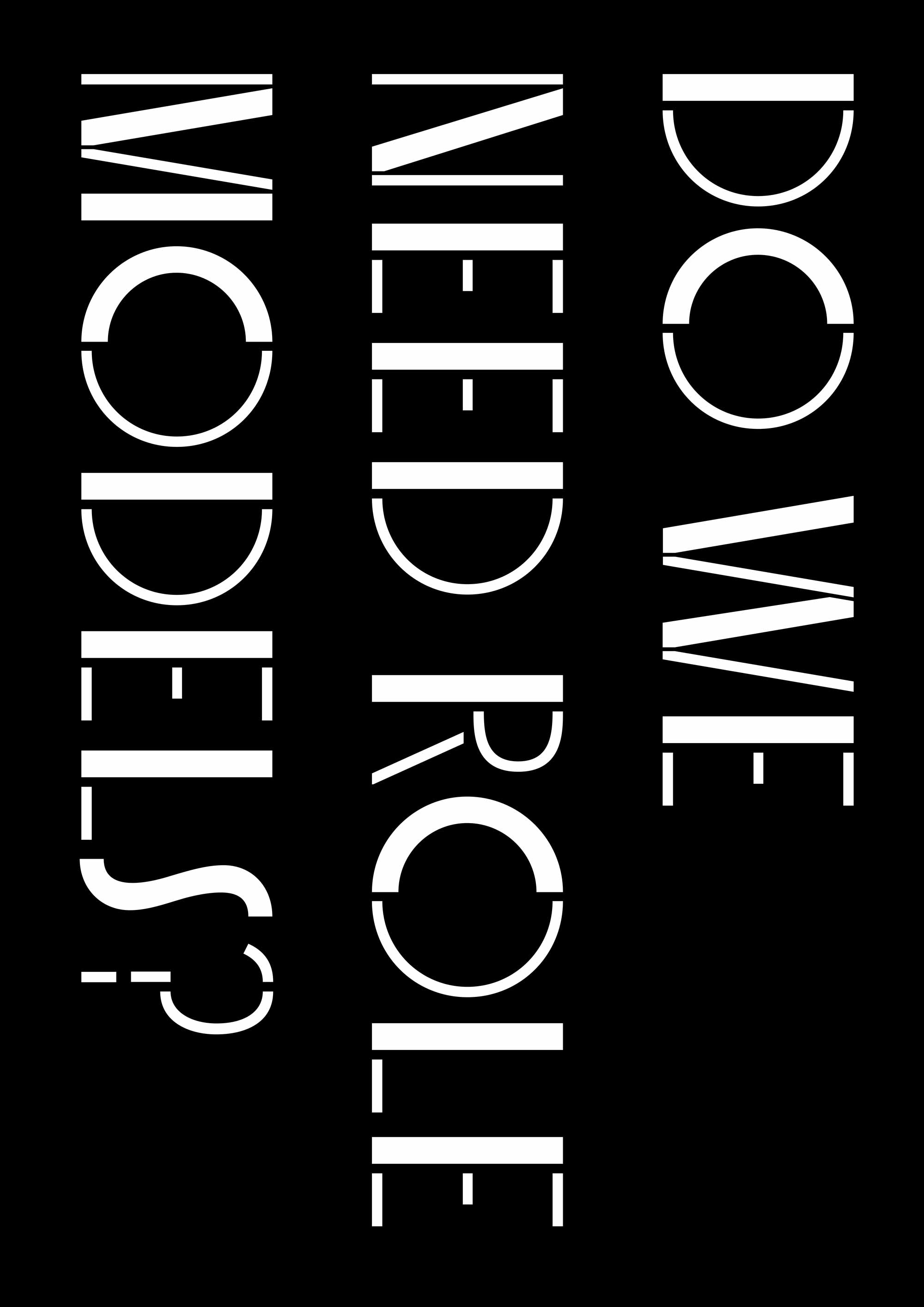 Font Sisters Two by Laura Meseguer
Font Sisters Two by Laura Meseguer
Annotations
- Originating from Simone de Beauvoir’s analysis in The Second Sex (Le Deuxième Sexe), ‘othering’ refers to how women, and by extension marginalised groups, are cast as the ‘Other’ (l’Autre) in contrast to a normative ‘Self’ (typically a white, heterosexual male). This process alienates and dehumanises the ‘Other,’ denying them full subjectivity, agency, and inclusion in societal narratives. While the original French term centres on ‘l’altérité’ (otherness) and ‘l’Autre’ to capture this dynamic of marginalisation, the specific verb form ‘othering’ is more commonly used in English-language feminist discourse.
** This principle is based on Karl Marx’s ideas expressed in Critique of the Gotha Programme (1875).
An abridged version of this text can be found in the DESIGN EQUITY issue of the DESIGNABILITIES Design Research Journal
 Exhibition view 2, Same Bold Stories, Foto: _turbo type
Exhibition view 2, Same Bold Stories, Foto: _turbo type Exhibition view 1, Same Bold Stories, Foto: _turbo type
Exhibition view 1, Same Bold Stories, Foto: _turbo type Exhibition view 3, Same Bold Stories, Foto: _turbo type
Exhibition view 3, Same Bold Stories, Foto: _turbo type Font Gupper by Giulia Boggio
Font Gupper by Giulia Boggio Font Violet by Carmen Nacher
Font Violet by Carmen Nacher Font Sisters Two by Laura Meseguer
Font Sisters Two by Laura Meseguer